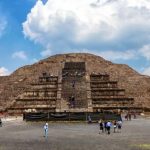 Music
Music  Music
Music  History
History 10 Less Than Jolly Events That Occurred on December 25
 Weird Stuff
Weird Stuff 10 Funny Ways That Researchers Overthink Christmas
 Politics
Politics 10 Political Scandals That Sent Crowds Into the Streets
 Weird Stuff
Weird Stuff Ten Bizarre Facts About The Doge Meme
 Our World
Our World 10 Ways Your Christmas Tree Is More Lit Than You Think
 Movies and TV
Movies and TV The 10 Coolest Stars to Set Sail on The Love Boat
 History
History 10 Things You Didn’t Know About the American National Anthem
 Technology
Technology Top 10 Everyday Tech Buzzwords That Hide a Darker Past
 Humans
Humans 10 Everyday Human Behaviors That Are Actually Survival Instincts
 Music
Music 10 Surprising Origin Stories of Your Favorite Holiday Songs
 History
History 10 Less Than Jolly Events That Occurred on December 25
 Weird Stuff
Weird Stuff 10 Funny Ways That Researchers Overthink Christmas
Who's Behind Listverse?

Jamie Frater
Head Editor
Jamie founded Listverse due to an insatiable desire to share fascinating, obscure, and bizarre facts. He has been a guest speaker on numerous national radio and television stations and is a five time published author.
More About Us Politics
Politics 10 Political Scandals That Sent Crowds Into the Streets
 Weird Stuff
Weird Stuff Ten Bizarre Facts About The Doge Meme
 Our World
Our World 10 Ways Your Christmas Tree Is More Lit Than You Think
 Movies and TV
Movies and TV The 10 Coolest Stars to Set Sail on The Love Boat
 History
History 10 Things You Didn’t Know About the American National Anthem
 Technology
Technology Top 10 Everyday Tech Buzzwords That Hide a Darker Past
 Humans
Humans 10 Everyday Human Behaviors That Are Actually Survival Instincts
10 Innovations and Discoveries Made by Monks
The monastic way of life—of work, prayer, and silent contemplation—is conducive to the germination of original ideas. Monasteries, which in the Middle Ages preserved classical knowledge, gave monks an intellectual edge not available to common folk. As early as the 11th century, we read of Eilmer of Malmesbury, the “Flying Monk,” who built a glider in which he actually flew for a short distance. In the 13th century, the Franciscan monk Roger Bacon was a proponent of experimental science and the scientific method.
Aside from science, monks made their contributions in other little ways—in education, music, business, and even food. Here we present the most important monastic discoveries and novelties that are very much part of modern, everyday life.
Related: 10 Inventions That Thrived in Ways Their Creators Never Expected
10 Armenian Alphabet
In AD 301, Armenia became the first country to officially adopt Christianity as its state religion. But it was another matter to actually convert the polytheistic inhabitants to the faith, and the methods used were often vicious and cruel. Early in the 5th century, a monk named Mesrop Mashtots realized that his fellow Armenians’ unfamiliarity with written Christian scriptures and liturgy had much to do with their resistance to conversion. Armenia lacked a formal writing system, so Mashtots determined to give the people their own alphabet by which to translate Christian texts.
Legend says that Mashtots had a divine vision that revealed the alphabet to him. More likely, Mashtots—who was a theologian and linguist—modified an ancient Armenian script that had been lost. The revived and updated alphabet had 38 letters—31 consonants and 7 vowels—probably influenced by the Pahlavi script from Persia and the Greek alphabet, perfectly suited to the complex sounds of the Armenian language. The first Armenian Bible was produced in AD 410. Mashtots established schools such as the Amaras Monastery in present-day Nagorno-Karabakh to teach the alphabet.
More than just facilitating the spread of Christianity, the alphabet gave Armenians a national identity and was a unifying force that helped them resist invaders and assimilation by foreign cultures. It is still in use to this day.[1]
9 Calendar
From the time the Council of Nicaea in AD 325 decreed that Easter must fall on the first Sunday after the first full moon following the vernal equinox, the Church had a problem figuring out what day of the year this would occur. In AD 525, a Scythian monk named Dionysius Exiguus was poring over these Easter tables—computations used to determine Easter’s date—when he came up with the idea of counting the years from Christ’s birthAt the time, years were counted from the reign of the Roman emperor Diocletian, a notorious persecutor of Christians, and Dionysius didn’t want to perpetuate the memory of the tyrant.
Perhaps using testimony from earlier Church fathers such as Clement of Alexandria and Eusebius of Caesarea, Dionysius pegged Jesus’ birth year as AD 1—Anno Domini, or “in the year of our Lord”—thus making year 247 on the Diocletian system equal to AD 532, the year of the first Easter table using the new calendar. Modern estimates reckon Dionysius was off by a few years and that Jesus was actually born around 6 to 4 BC.
Dionysius didn’t concern himself with the years before Jesus—that was left to another monk, the Venerable Bede. In AD 731, Bede completed his Ecclesiastical History of the English People, which used the AD system and expanded it by using BC to denote years “before Christ.” Bede’s work popularized the BC/AD system, and by the 15th century, all of Western Europe had adopted it.[2]
8 Pretzels
The widely accepted origin story of the pretzel traces its roots back to a monastery near Aosta, Italy, in AD 610. It was Lent, the period of penitence, when Christians prayed and fasted with their arms folded across their chests and each hand resting on the opposite shoulder. A young monk preparing unleavened bread had the idea of twisting the dough to resemble this prayer stance and giving the bread to children as a reward for saying their prayers. The three holes represented the Trinity. He called the bread pretiola, or “little reward.”
The monk’s creation spread to the rest of Europe. By the 15th century, the distinctive shape had come to symbolize good luck, prosperity, and long life—becoming especially popular in Germany, where it was eaten with hard-boiled eggs on Good Friday. The pretzel is now commonly associated with Germany, and it was the Palatine Germans, or Pennsylvania Dutch, who introduced the “bretzel” to America in 1710.[3]
7 Musical Notation
Prior to the 11th century, liturgical music was notated by markers called neumes. They were little squiggles above the lyrics, sliding up, down, twisting, or turning. They gave the singer a general idea of the melody—whether to raise or lower the pitch—but they did not specify actual notes. One had to hear the chant beforehand in order to learn it by rote and sing it accurately.
A monk named Guido of Arezzo realized how frustrating it was to teach a new choir the liturgical chants. It normally took ten years to perfect a repertoire for an ecclesiastical singer. In 1025, Guido devised a system that enabled a student to learn a song he had never heard before. He introduced the staff and letters as clefs, supplementing the already existing F and C lines with two more lines on which the neumes were placed, enabling accurate determination of pitch.
With his new music notation, Guido reduced a singer’s training period from ten years to one. Our modern notation system is the result of later improvements upon the basic scheme that Guido of Arezzo laid down.[4]
6 Universities
Education was monopolized by monasteries in the Middle Ages. In monastic schools, the classical learning of Greece and Rome was preserved from oblivion by monks dedicated to copying precious texts. They also taught grammar, rhetoric, and logic along with theology. The Benedictine Rule shaped the curriculum, balancing prayer, contemplative study, and work. Charlemagne promoted scientific inquiry and expanded libraries and curricula to include mathematics and medicine. Families who consecrated their children to religious life sent them to these schools, which proliferated from the 6th to the 9th centuries.
The rise of cities saw schools attached to cathedrals, and charismatic teachers like the scholar-scientist Gerbert of Aurillac (the future Pope Sylvester II) attracted students from across Europe. An explosion of knowledge in the 11th and 12th centuries—with the influx of Latin and Arab texts—added history, philosophy, and science to the curriculum, transmitted through a new institution: the Studium Generale, or university. Texts translated by monks like Constantine the African were fundamental to university instruction up to the 16th century.
Many modern universities are secular, but we are still reminded of their monastic origins through the graduation toga, which imitates the clerical garb worn by teachers and students of the medieval university.[5]
5 Mechanical Clock
“The clock, not the steam engine, is the key machine of the modern industrial age,” wrote historian Lewis Mumford. Every facet of our society, at home or at work, is geared toward counting time. The need for an accurate timepiece arose in the medieval monastery, where life was structured around regularity and order—a refuge from the dark, chaotic world after the fall of the Roman Empire.
Regularity was enforced by the ringing of the bell seven times a day to call monks to prayer. Sundials and water clocks were used to tell the hours, but what to do when the day was overcast or when winter cold froze the water? The scientist and mechanical genius Gerbert of Aurillac, whose intellectual prowess led many to suspect he was in league with the Devil, set his mind to the problem. In 996, Gerbert invented a bell-ringing device that operated at regular intervals, which became the basis for the concept of the mechanical clock.
By the 13th century, the clock had evolved into the gear-driven mechanism that watchmakers are familiar with today. It was also in this century that the hour was divided into 60 minutes and the minute into 60 seconds. For the next 400 years, Gerbert’s invention was improved upon by others. It had been widely adopted by the secular world by the 15th century.[6]
4 Parmesan Cheese
The cheese known as Parmigiano Reggiano, or Parmesan, was introduced by Benedictine and Cistercian monks in the 13th century. The monasteries of the Parma-Reggio region of Italy owned granges, or farms, stocked with cows from which the monks procured their milk. The cheese was the result of their search for a way to extend the shelf life of milk. By adding salt from the Salsomaggiore mines to the milk, the monks obtained the dry paste cheese in large wheels that could last a long time.
In 1254, we already have the first evidence that the cheese was being sold in far-off Genoa. In the 14th century, it was being traded in Romagna, Piedmont, Tuscany, and Mediterranean ports. In 1612, the Duke of Parma designated the region the official place of Parmesan cheese production to protect the product from similar cheeses.
Except for innovations like fermented whey and steam heating, Parmigiano Reggiano is still made today the way monks did it in the Middle Ages—naturally and without additives. Which means that the grated “Parmesan” being sold in the United States cannot legally be sold in Italy under that designation.[7]
3 Modern Accounting
As trade and commerce grew in the High Middle Ages, more accurate methods of keeping track of transactions became more important. Luca Pacioli had been taken in by a wealthy merchant after being orphaned and knew the intricacies of business from a young age. He received practical schooling in mathematics while earning a theology degree from the University of Perugia, after which he became a friar in the Franciscan Order.
Pacioli spent the next years teaching, traveling, and writing. He became close friends with Leonardo da Vinci, who had an enthusiastic interest in mathematics. In 1506, Pacioli became superior of the Franciscans and entered the monastery of Santa Croce in Florence.
Double-entry accounting had been in use in Italy for hundreds of years before Pacioli, but it was he who first systematized and described the method in full in his book Summa de Arithmetica, published in 1494. It drew on Pacioli’s knowledge of balance sheets, income statements, trial balances, and debits and credits used by the Venetian tradesmen with whom he once worked. Pacioli introduced terms now common in the business world—assets, liabilities, capital, income, and expense account.
These ideas may not have been original to Pacioli, but his work made the widespread adoption of the double-entry system possible, fueling the rise of free markets and capitalism in Europe and North America. For this reason, Pacioli is hailed as the Father of Modern Accounting.[8]
2 Champagne
He is perhaps the world’s most famous monk—at least for wine connoisseurs—but Dom Pierre Pérignon did not actually invent champagne. It had been around since the 1st century AD, but it was a weak, red wine, not very enjoyable to drink. Dom Pérignon changed all that. He entered the Benedictine Abbey of Hautvillers in the Champagne region of northeastern France. He maintained its wine cellars until he died in 1715. At the time, people, not surprisingly, regarded that region’s wines poorly, and the French court shunned it entirely, preferring the red wines of Burgundy and Bordeaux.
Pérignon’s job as cellar master enabled him to experiment with wine. He determined that a particular vineyard’s natural environment—soil, topography, climate, and other factors—produced grapes that gave the wine a distinctive flavor. He began to grow the Pinot Noir variety, more suitable to the climate of the region. By controlling the blending of Pinot Noir and Chardonnay, he produced wines of the best quality while also solving the problem of deposit formation that accompanied double fermentation (necessary in making sparkling wine), which gave the wine an unpleasant taste.
Dom Pérignon’s white wines were a resounding success. For the first time, the drink was associated with a person’s name rather than the region where it was grown. His business sense helped his monastery overcome its financial difficulties, and his production methods vastly improved champagne and turned it into the drink we enjoy today.[9]
1 Modern Genetics
Gregor Mendel was a poor rural kid in Silesia, in present-day Hynčice, Czechia, who loved flowers and watching the sky and stars. A local priest who saw his academic potential recommended him to school, where he could barely support himself. Mendel saw more promise in Altbrunn Monastery, which valued scientific research and education, and he entered as an Augustinian novitiate in 1843.
A shy and quiet man, Mendel was happiest in the monastery’s botanical garden, breeding fuchsias and pea plants. He did not plan on conducting controlled genetic experiments at first; he merely wanted to produce hybrid peas. But as Mendel observed the process, his curiosity was aroused. In 1854, the abbot permitted Mendel to conduct a major experiment to trace the transmission of hereditary characteristics in successive generations of hybrid progeny. Using well-controlled and brilliantly designed methods, Mendel worked for eight years, growing thousands of peas and keeping meticulous notes.
From his observations, Mendel discovered the principles of genetic inheritance. He described the now-familiar concepts of dominant and recessive traits. In 1865, Mendel presented his conclusions to the Brünn Society for Natural Science and submitted his paper the next year. His work was too far ahead of its time to be appreciated by scientists. Mendel continued his scientific experiments, keeping extensive meteorological and stellar records. He died of kidney failure on January 6, 1884. Mendel would gain posthumous recognition after scientists replicated his results in the 20th century, earning him the title “Father of Modern Genetics.”[10]








